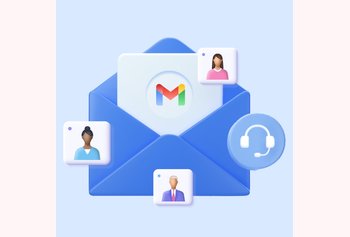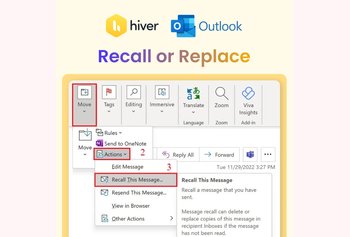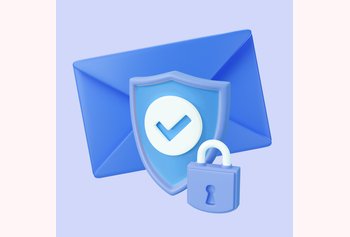What is Gmail Confidential Mode and How To Use It?
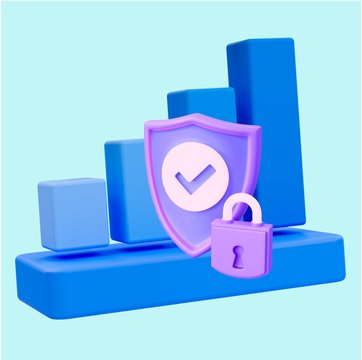
Table of contents
I work in marketing so you can imagine how important email communication is for me. From sending reports to my manager to doing cold outreach for partnership opportunities, there’s not a day (minus the weekends) where I’m not in my inbox.
But beyond using email for my responsibilities at work, there are also times when I use it to share sensitive information such as identification proofs or tax slips.
And that got me thinking: What if someone tries to misuse such information? Are there any precautions I can take before sharing sensitive data over email?
Turns out there is a feature in Gmail for this. It’s called Confidential Mode.
Gmail Confidential Mode was created to help people send sensitive information in a secure way over email. It lets you set rules for emails, like making them expire after a particular time or stopping others from forwarding, copying, or printing them.
In this article, we’ll explore what Gmail Confidential Mode is and the best practices to use it in the right way.
Table of Contents
- What is Gmail Confidential Mode?
- How to use Gmail Confidential Mode? A step-by-step guide
- Best practices for implementing Gmail Confidential Mode
- Limitations of Gmail Confidential Mode
- How to Turn On Gmail Confidential Mode on Mobile
- Leverage Gmail Confidential Mode to improve security
- Frequently Asked Questions (FAQs)
What is Gmail Confidential Mode?
Let’s try to understand Gmail’s confidential mode in detail.
Gmail Confidential Mode is a feature that allows users to send emails with added security and control. It helps protect sensitive information by enabling the sender to set an expiration date for an email, restricting how the email can be used, and even revoking access after the email has been sent.
This mode is designed to safeguard private communication, ensuring that the contents of the email can’t be easily shared or accessed without permission.
For example, suppose you’re a financial advisor and need to share the tax return of a client via email. Typically, the recipient could forward or print it, but that could expose private information.
With Gmail Confidential Mode, you can:
– Make the email expire in a week so the recipient can’t access it forever.
– Stop the email from being forwarded or printed.
– Add a layer of security for the email by asking the recipient to enter a passcode (sent to their phone).
Key features and benefits of Gmail confidential mode
- Expiration dates for emails
One of the main features of Confidential Mode is the ability to set an expiration date for your emails. This means the recipient can only access the email temporarily, as it will become unavailable after a while. This is useful when you have to send time-sensitive or confidential information that shouldn’t be stored indefinitely.
- Revoking access to sent emails
Even after an email has been sent, you can still revoke the recipient’s access to it. You can remove access anytime if you change your mind or realize the information is unavailable. This gives you more control over sensitive data even after sharing it.
- Preventing forwarding, copying, and printing
Confidential Mode prevents recipients from forwarding your email to others or copying, downloading, or printing its contents. This helps in adding an extra layer of protection to your email. It also ensures that your message stays within the intended hands, reducing the risk of data leaks.
- SMS passcode verification
For even more security, you can require recipients to enter a passcode to view the email. Gmail will send a one-time passcode to the recipient’s phone, ensuring only that person can access the email.
- Compliance with privacy regulations
Many businesses must comply with strict data privacy regulations, such as GDPR or HIPAA, which demand secure handling of sensitive data. Confidential Mode helps companies meet these requirements by preventing recipients from forwarding, copying, or printing sensitive emails.
- Building trust with clients and partners
Another advantage of using Gmail Confidential Mode is that it helps with your reputation by showing clients and partners that you take data security seriously. By ensuring secure communication channels, you demonstrate your commitment to protecting sensitive information.
How to use Gmail Confidential Mode? A step-by-step guide
1. Enabling Confidential Mode
- Step 1: Open Gmail and click the “Compose” button
- Step 2: Look for the lock icon with a clock at the bottom of the email window. This is the Confidential Mode button.
- Step 3: Click the lock icon to enable Confidential Mode. A pop-up window with security options will appear.
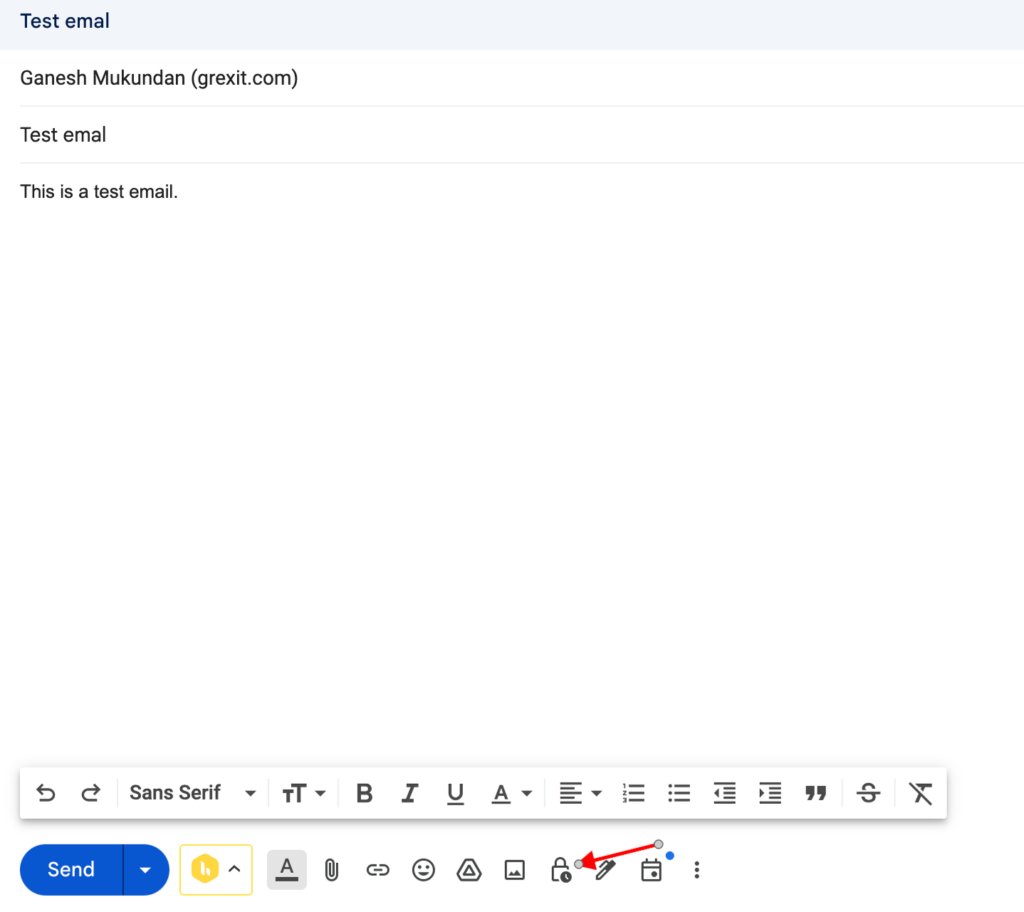
2. Setting Expiration Dates and Passcodes
- Step 1: In the Confidential Mode pop-up, choose an expiration date for your email. You can set it to expire in 1 day, 1 week, 1 month, 3 months, or 5 years.
- Step 2: Select the “SMSPasscode” option for extra security. Gmail will send a one-time code to the recipient’s phone, which they must enter to open the email.
- Step 3: If you don’t need this, you can choose “No SMS Passcode,” which allows the recipient to open the email without a passcode.
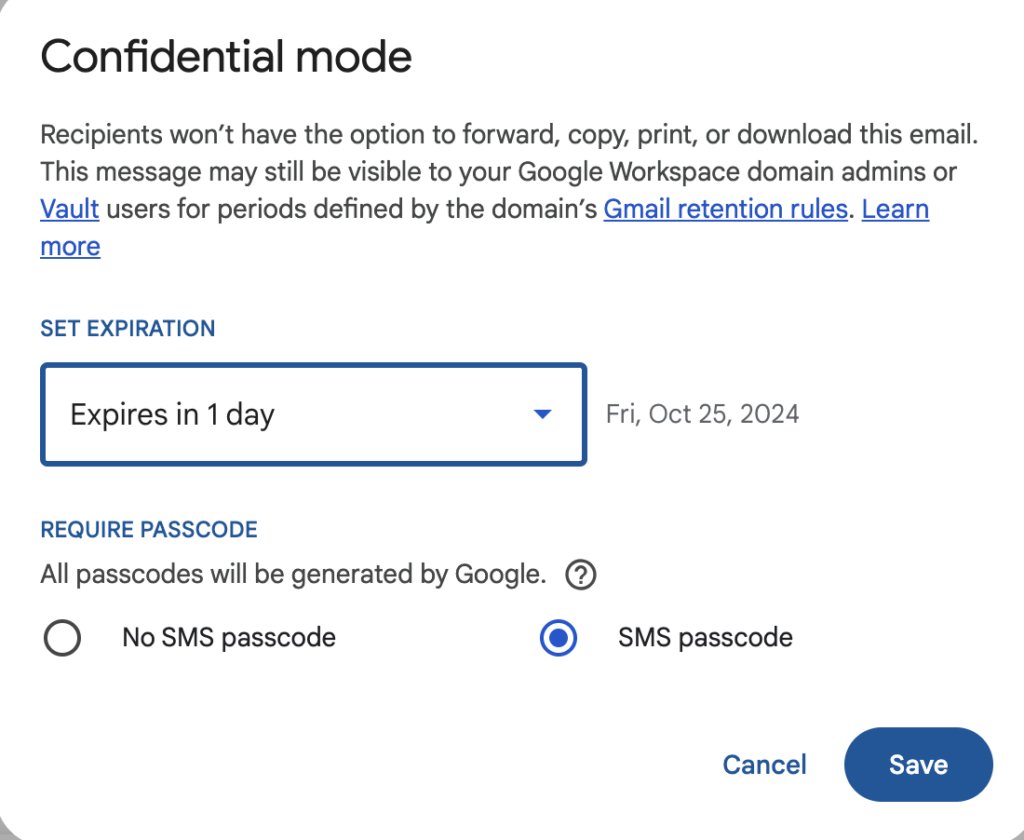
3. Managing sent confidential emails
- Step 1: After sending the email, you can access it from your “Sent” folder.
- Step 2: To revoke access, open the confidential email and click “Remove access.” This will prevent the recipient from viewing the email again.
- Step 3: You can check if the recipient still has access by opening the email in your Sent folder and reviewing the access status.
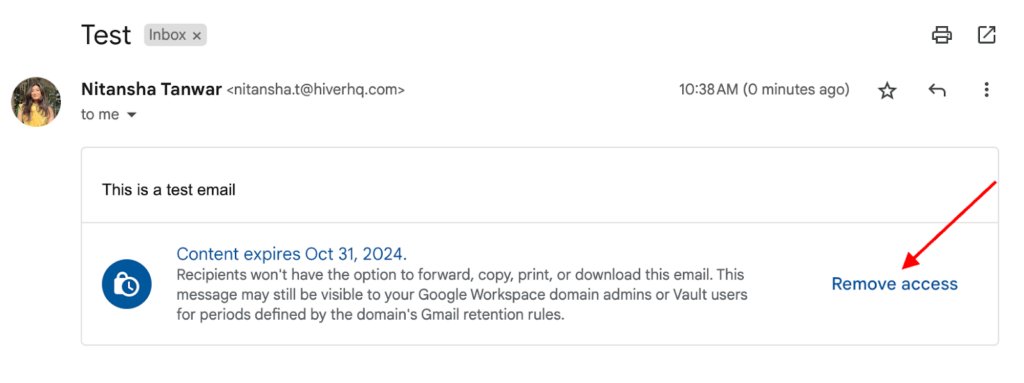
4. Recipient experience and access
- Step 1: When the recipient receives your confidential email, they will see a message that the email is protected by Confidential Mode.
- Step 2: If you’ve chosen the SMS Passcode option, they will receive a text message with a code they must enter to access the email.
- Step 3: The recipient cannot forward, copy, download, or print the email. These restrictions help keep your information secure.
Best practices for implementing Gmail Confidential Mode
To make the most out of Gmail Confidential Mode, you can leverage these best practices:-
- Developing a company policy: Before rolling out Confidential Mode across your organization, it’s essential to establish a clear policy for its use. Here’s what you can do:-
Checklist for Implementing Confidential Mode in Your Organization
Establish a clear policy for Confidential Mode usage: Define the purpose and scope of using Confidential Mode within the organization.
Specify scenarios where Confidential Mode should be used, such as:
– Handling sensitive client information
– Managing financial data
– Protecting internal documents
Outline email types requiring Confidential Mode: List the types of emails that need additional security, ensuring they meet confidentiality standards.
Assign compliance oversight responsibilities: Designate team members responsible for ensuring adherence to Confidential Mode policies.
Standardize usage across the organization: Develop a protocol for consistently applying Confidential Mode to relevant communications, ensuring company-wide compliance.
- Training employees on proper usage: It’s important to train employees on how to use Confidential Mode properly. You can provide them with detailed guidance on when and why to use it, along with step-by-step instructions for enabling features like expiration dates and SMS passcodes. Ensure that employees understand the limitations of Confidential Mode, such as the fact that it doesn’t prevent recipients from taking screenshots. Regular training sessions or workshops can help staff stay updated on best practices. This helps foster a security-conscious culture.
- Implement stronger encryption practices: If using Gmail is necessary, consider encrypting sensitive documents before emailing them. Tools like VeraCrypt or 7-Zip can encrypt files, ensuring that only intended recipients can access them.
Note: When it comes to sharing attachments, Gmail Confidential Mode might have some limitations. So, how can you send an encrypted email with attachments in Gmail? You can send it as a zip file and share the key to open that zip file with the recipient. This Reddit thread explains it better.
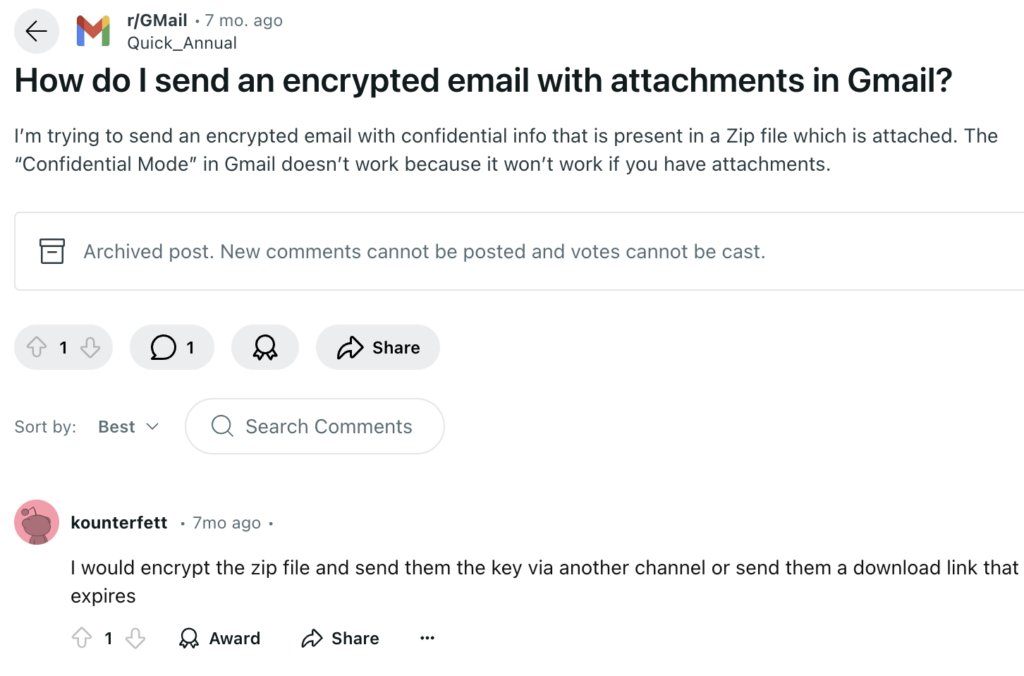
- Integrating with existing security measures: Confidential Mode should complement, not replace, your existing security measures. Make sure that it is integrated with other tools like two-factor authentication (2FA). This way, your organization can benefit from multiple layers of protection. Additionally, regularly review how Confidential Mode fits into your overall email security strategy to identify areas for improvement or necessary adjustments.
Recommended Reading: 23 Email Management Best Practices and Tips
Limitations of Gmail Confidential Mode
Even though Gmail Confidential Mode allows users to send emails in a secure manner, experts argue that this feature does not provide genuine confidentiality. For example:-
- Lack of End-to-End Encryption: One of the primary criticisms is that emails sent in Confidential Mode are not end-to-end encrypted. This means that Google can still access the contents of these emails, undermining the very notion of confidentiality.
In fact, Writing for PCWorld, Null states,”Confidential mode isn’t really confidential at all. While it does offer some safeguards against casual snooping, it doesn’t actually encrypt messages end to end, nor does it prevent Google from reading your messages or turning them over to authorities.” - Vulnerability to Screenshots: Despite restrictions on forwarding and printing, recipients can easily take screenshots of the email content. This capability might rend many of the protective features ineffective.
- Data Retention Concerns: Even after an email expires, there is uncertainty on how long Google retains these messages on its servers. Users may feel reassured by expiration settings, but Google can still access these emails post-expiration.
So, what can one do in that case? Here are some options that provide better security features:-
Secure alternatives to Gmail confidential mode
- ProtonMail is known for its strong encryption and focus on privacy. It provides end-to-end encryption for all emails, meaning only the sender and recipient can read the messages.
- Tutanota is a secure email service that also uses end-to-end encryption to keep your messages private. It is a user-friendly tool and offers features like encrypted calendars and contact management.
- StartMail is a Netherlands-based service that protects your privacy. It lets you create temporary email addresses to help keep your identity anonymous.
- Mailfence is a user-friendly alternative that offers OpenPGP encryption.
These alternatives offer varying levels of security and features tailored for users concerned about confidentiality in their communications.
How to Turn On Gmail Confidential Mode on Mobile
To enable Gmail Confidential Mode on mobile devices, follow these straightforward steps for both Android and iOS:
Steps to Turn On Gmail Confidential Mode on Mobile
- Open the Gmail App: Launch the Gmail application on your mobile device.
- Compose a New Email: Tap the Compose button (usually represented by a pencil icon) to start a new email.
- Access More Options: In the new email window, look for the three-dot menu (More) at the screen’s top right corner.
- Find Confidential Mode: Tap on Confidential mode from the dropdown menu. This will open a pop-up window with options for setting up Confidential Mode.
- Enable Confidential Mode: Toggle the switch to turn on Confidential Mode.
- Set Expiration Date and Passcode:
- Choose an expiration date for your email from options such as 1 day, 1 week, 1 month, 3 months, or 5 years.
- Optionally, you can require a passcode for added security. If you select this option, you will need to enter the recipient’s phone number so that Gmail can send them an SMS with the passcode.
- Save Your Settings: After adjusting your settings, tap Save to apply them.
- Finish Composing Your Email: Complete your email as usual and hit send.
You can also refer to the video below.
Leverage Gmail Confidential Mode to improve security
Gmail Confidential Mode is a simple yet powerful way to secure sensitive information. With features like expiration dates, restricted access, and prevention of forwarding or printing, it adds an extra layer of protection to your emails.
You can take advantage of these security features by setting up a clear policy on when to use confidential mode and ensuring employees know how to use it. Implementing this will show your clients and partners you’re serious about keeping their data safe.
Frequently Asked Questions (FAQs)
1. What does Confidential Mode do in Gmail?
As far as email security is concerned, Gmail’s Confidential Mode improves how recipients can interact with sensitive information. It restricts anyone from forwarding, copying, printing, or downloading the email content.
2. What happens when you send a confidential email?
When you send a confidential email using Gmail’s Confidential Mode, the recipient faces several restrictions: they cannot forward, copy, print, or download the email or its attachments. You can set an expiration date for the email, after which it becomes inaccessible, and you can require a passcode for access, which is sent via SMS to the recipient. Additionally, you can revoke access to the email at any time, maintaining control over sensitive information. However, it’s important to note that while these features enhance security, they do not prevent recipients from taking screenshots or photos of the content.
3. Does confidential mode delete the email?
Gmail’s Confidential Mode does not automatically delete emails after the expiration date. When you send a confidential email and set an expiration date, the recipient loses access to the email after the set date, but the email remains in the sender’s “Sent” folder. If the sender wants to permanently delete the email, they must manually remove it from their sent items. Once deleted, Gmail will permanently erase it after 30 days, making it irretrievable. Therefore, while Confidential Mode restricts access for recipients, it does not automatically delete emails; manual deletion is required to remove the email permanently.
4. Does Gmail confidential mode work to non-Gmail accounts?
Yes, Gmail’s Confidential Mode works with both Gmail and non-Gmail accounts. But, if the recipient uses a non-Gmail account, they will receive a link to a secure Google webpage to access the email. This means that while the feature is functional across different email platforms, the user experience varies slightly depending on whether the recipient is using Gmail or another email service provider.












